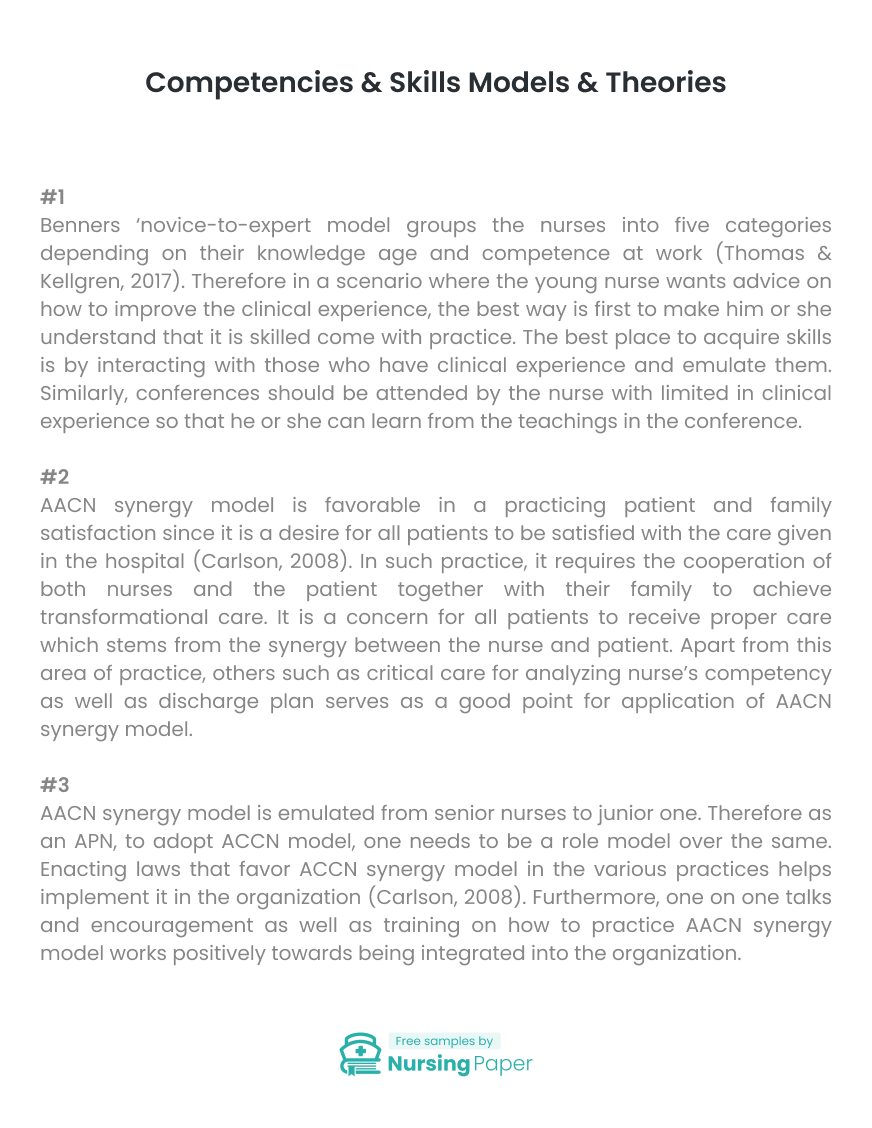
Competencies & Skills Models & Theories
#1
Benners ‘novice-to-expert model groups the nurses into five categories depending on their knowledge age and competence at work (Thomas & Kellgren, 2017). Therefore in a scenario where the young nurse wants advice on how to improve the clinical experience, the best way is first to make him or she understand that it is skilled come with practice. The best place to acquire skills is by interacting with those who have clinical experience and emulate them. Similarly, conferences should be attended by the nurse with limited in clinical experience so that he or she can learn from the teachings in the conference.
#2
AACN synergy model is favorable in a practicing patient and family satisfaction since it is a desire for all patients to be satisfied with the care given in the hospital (Carlson, 2008). In such practice, it requires the cooperation of both nurses and the patient together with their family to achieve transformational care. It is a concern for all patients to receive proper care which stems from the synergy between the nurse and patient. Apart from this area of practice, others such as critical care for analyzing nurse’s competency as well as discharge plan serves as a good point for application of AACN synergy model.


#3
AACN synergy model is emulated from senior nurses to junior one. Therefore as an APN, to adopt ACCN model, one needs to be a role model over the same. Enacting laws that favor ACCN synergy model in the various practices helps implement it in the organization (Carlson, 2008). Furthermore, one on one talks and encouragement as well as training on how to practice AACN synergy model works positively towards being integrated into the organization.
#4
In Relationship-based care, long-term care is ideal for advanced nursing practices. With this relationship-based care, the assessment of nurse to patient, nurse to nurse and nurse to system outcome can be measured by determining easily of work on the nurse as he or she carries out the duties, evaluating the communication between other nurses and patients and commitment, collaboration and competence. If the outcome is positive, then relationship-based-care was effective (Erickson & Wilke, 2014).
1. Carlson, K. (2008). AACN Advanced Critical Care Nursing. Philadelphia: Elsevier Health Sciences.
2. Erickson, S., & Wilke, J. (2014). Relationship-based care. A constituent in the nursing profession
3. Thomas, C., & Kellgren, M. (2017). Benner’s Novice to Expert Model: An Application for Simulation Facilitators. Nursing Science Quarterly, 30(3), 227-234.



The download will start shortly.

The download will start shortly.
 Subject:
Nursing
Subject:
Nursing  Number of pages: 5
Number of pages: 5  Subject:
Nursing
Subject:
Nursing  Number of pages: 2
Number of pages: 2  Subject:
Nursing
Subject:
Nursing  Number of pages: 4
Number of pages: 4  Subject:
Health and Social Care
Subject:
Health and Social Care  Number of pages: 3
Number of pages: 3  Subject:
Health and Social Care
Subject:
Health and Social Care  Number of pages: 2
Number of pages: 2  Subject:
Health and Social Care
Subject:
Health and Social Care  Number of pages: 3
Number of pages: 3  Subject:
Nursing
Subject:
Nursing  Number of pages: 2
Number of pages: 2  Subject:
Nursing
Subject:
Nursing  Number of pages: 11
Number of pages: 11  Subject:
Health and Social Care
Subject:
Health and Social Care  Number of pages: 7
Number of pages: 7  Subject:
Medicine
Subject:
Medicine  Number of pages: 6
Number of pages: 6  Subject:
Nursing
Subject:
Nursing  Number of pages: 6
Number of pages: 6  Subject:
Nursing
Subject:
Nursing  Number of pages: 5
Number of pages: 5  Subject:
Nursing
Subject:
Nursing  Number of pages: 2
Number of pages: 2  Subject:
Health and Social Care
Subject:
Health and Social Care  Number of pages: 10
Number of pages: 10  Subject:
Nursing
Subject:
Nursing  Number of pages: 22
Number of pages: 22 
